The Low-Glycemic Diet: Food List, Recipes, Pros, And Cons
What you need to know before jumping onto this popular diet plan.

Image: Shutterstock
The low-glycemic diet is a dietary regimen characterized by a deliberate selection of foods with a low glycemic index (GI). Such foods are known for their capacity to induce gradual, controlled increases in blood glucose levels. The main objective of this dietary approach is to promote stable blood sugar levels that are associated with several health advantages. In the article below, we further explore the low-glycemic diet, its benefits and drawbacks, and a list of low and high-GI foods that you need to be aware of. Continue reading.
 At A Glance: The Low-Glycemic Diet
At A Glance: The Low-Glycemic Diet- Principle: Prioritizing intake of low-GI foods to stabilize blood sugar
- Purpose: Weight loss and blood sugar management
- Who It Is For: People who want to maintain or obtain a healthy weight and who want to stabilize their blood sugar levels
- Duration: Long-term (but may vary based on individual goals)
- Who Should Avoid: Pregnant or breastfeeding women, and individuals with nutritional deficiencies
- Cons: Requires one to constantly track food consumption, may increase the risk of nutritional deficiencies, can be restrictive, and may lead to overemphasis on GI and misinterpretation of the GI value of foods.
In This Article
What Is The Glycemic Index (GI)?
The Glycemic Index (GI) is a quantifiable scale utilized to assess and classify how particular carbohydrate-rich foods raise blood glucose levels following their intake. This scale provides a useful framework for evaluating the impact of different carbohydrates on blood sugar. It also helps individuals make informed dietary choices to achieve various health benefits.
The GI scale ranges numerically from 0 to 100, with higher values signifying foods that trigger an immediate and rapid surge in blood glucose levels upon consumption. Foods are categorized into groups based on their GI values. Those scoring below 55 are categorized as low GI, those between 56 and 69 as medium GI, and those scoring at 70 or above as high GI.
Understanding the GI of various foods offers invaluable insights, particularly for those who want to regulate their blood sugar levels or manage diabetes (1). Incorporating foods with a low GI can be an essential part of a diabetes diet, helping to stabilize blood sugar and improve overall health. GI can also be a valuable resource for those keen to manage their weight and improve their overall well-being.
Hence, routinely consuming foods classified as low-GI can help you in many ways. The section below gives an overview of the low-glycemic diet. Check it out.
Key Takeaways
- The low-glycemic diet is centered on the consumption of foods characterized by a low glycemic index (GI).
- Individuals with diabetes can especially benefit from it as it allows one to regulate and maintain blood sugar levels and enhances insulin sensitivity.
- It includes a diverse range of low-GI foods, including fruits, vegetables, legumes, and whole grains.
- However, one also must be aware of its drawbacks before going for it.
What Is The Low-Glycemic Diet?

The low-glycemic diet is a nutritional approach that focuses on consuming low-GI foods to help regulate blood sugar spikes and to help treat or reduce the risk of diabetes.
Low-GI foods include whole grains, legumes, non-starchy vegetables, and certain fruits including apples and oranges. These foods are preferred over high-GI foods like sugary snacks and simple carbohydrates.
Although many foods are classified as low-GI, several factors can still affect the glycemic index. On this note, knowing what the glycemic index is and what affects the Glycemic Index of a food will help you decide on your diet more efficiently. We will get more details in the next section.
What Affects The Glycemic Index Of A Food?
Carbohydrate Type:
The type of carbohydrates in a food determines its GI. Simple carbohydrates, like those found in sugar, tend to have a higher GI than complex carbohydrates like whole grains.
Fiber Content: Foods rich in dietary fiber often have a lower GI because fiber can slow down the absorption of sugar into the bloodstream. Whole grains, fresh fruits, and vegetables are good examples. Research shows that high-fiber and low-GI foods help lower postprandiali The period after a meal where changes in physiological parameters like blood sugar or triglyceride levels occur. glucose response (2).
Processing And Cooking Methods: Processing methods, like milling grains into flour, can affect a food’s GI as can cooking. For instance, cooking can change the glycemic impact of rice by gelatinization (which occurs when rice is heated in water, causing the starch granules to absorb water and swell). The degree of gelatinization can vary depending on the cooking method and duration. Overcooked rice with higher gelatinization tends to have a higher GI (3). Cooking methods like steaming vegetables tend to preserve their fiber content and keep their glycemic index lower than frying, which can increase the GI due to additional fats and higher temperatures breaking down the food’s structure. Similarly, because the wet heat helps maintain resistant starches that inhibit digestion, boiling potatoes results in a lower GI than baking them.
Ripeness: The ripeness of fruits can affect their GI. Riper fruits tend to have higher sugar content, primarily in the form of easily digestible carbohydrates such as glucose and fructose. This can result in a higher GI (4).
Food Combinations: The GI of a meal may also be influenced by how foods are combined. Pairing high-GI foods with low-GI foods may balance the overall GI of the meal. The fiber, protein, and fat in low-GI foods can slow down the digestion and absorption of carbohydrates from high-GI foods. This could result in better glucose control.
Choosing low-GI foods and carefully processing and cooking them to include in a low-glycemic diet can offer important benefits. We will explore this in the section below.
Benefits Of The Low-Glycemic Diet
- May Help Manage Blood Sugar Levels

A low-glycemic diet is very effective for regulating blood sugar levels. It prioritizes the intake of low-GI foods and allows one to control their blood glucose levels effectively (1).
Low-GI foods are absorbed more slowly into the bloodstream. Hence, they effectively prevent rapid blood sugar fluctuations (2). This is especially important for individuals with diabetes, as it ensures a more stable glucose profile throughout the day.
Low-GI diets also improve postprandial glycemia and can help people with diabetes lose body weight (5).
- May Improve Insulin Sensitivity
Low-glycemic diets may improve insulin sensitivityi A measure of how responsive body cells are to insulin, with high sensitivity indicating efficient glucose uptake and lower diabetes risk. , which is a major factor in blood sugar regulation. Insulin resistance, a condition where cells become less responsive to insulin’s signals, is one major cause of type 2 diabetes (6). Moreover, following an insulin resistance diet emphasizing low-GI foods can effectively reduce the risk of insulin resistance and promote insulin sensitivity (1).
- May Help Maintain Energy Levels
Low-GI foods are mostly rich in complex carbohydrates. Including these in a regular diet offers a sustained release of energy over an extended duration. This helps prevent energy crashes and fatigue (7).
Such foods also help prevent rapid fluctuations in blood glucose levels, which may otherwise cause tiredness and irritability (8).
- May Help Control Appetite

Low-GI diets may curb appetite and enhance satiety as they are typically loaded with complex carbohydrates and fiber. This can be especially advantageous for individuals aiming for weight management (9).
- May Aid In Weight Loss
Low-glycemic diets can contribute to weight loss by preventing excessive calorie intake and stimulating the utilization of stored fat for energy. These diets regulate appetite and prevent overeating. They also may promote fat and weight loss (10).
- May Promote Heart Health

Low-glycemic foods lower unfavorable triglyceridei Fats stored in the body's fat cells and released into the bloodstream for energy between meals, the high levels of which may lead to heart disease. levels and elevate HDL (good) cholesterol concentrations in the bloodstream. In this way, they can help reduce the risk of cardiovascular ailments (11).
- May Reduce The Risk Of Chronic Diseases
Intake of low-glycemic foods can reduce the risk of chronic diseases, such as cardiovascular disorders, specific cancers, and type 2 diabetes (12). Low-GI foods do not trigger excess insulin secretion, which may eventually cause insulin resistance and a host of other chronic ailments.
There are many varieties of low-GI foods that you can incorporate into your diet to reap these benefits. The section below lists these foods. Check them out.
List Of Low-Glycemic Index Foods
Low-GI Fruits
- Cherries (1 cup) – GI: 22
- Grapefruit (½, medium) – GI: 25
- Apple (1, medium) – GI: 34
- Pear (1, medium) – GI: 38
- Plums (2, medium) – GI: 39
- Peach (1, medium) – GI: 42
- Orange (1, medium) – GI: 44
- Strawberries (1 cup) – GI: 40
- Apricots (3, medium) – GI: 34
- Kiwi (1, medium) – GI: 53
Low-GI Vegetables
- Spinach (1 cup) – GI: 15
- Broccoli (1 cup) – GI: 10
- Cauliflower (1 cup) – GI: 15
- Green beans (1 cup) – GI: 30
- Tomato (1, medium) – GI: 15
- Bell pepper (1, medium) – GI: 10
- Zucchini (1, medium) – GI: 20
- Leafy greens (1 cup) – GI: 10
- Brussels sprouts (1 cup) – GI: 30
- Eggplants (1 cup) – GI: 15
Low-GI Legumes And Pulses
- Chickpeas (½ cup) – GI: 28
- Lentils (½ cup) – GI: 29
- Kidney beans (½ cup) – GI: 24
- Black beans (½ cup) – GI: 30
- Soybeans (½ cup) – GI: 15
- Peanuts (¼ cup) – GI: 7
Low-GI Grains And Cereals
- Barley (½ cup) – GI: 28
- Quinoa (½ cup) – GI: 53
- Whole wheat pasta (½ cup, cooked) – GI: 37
- Steel-cut oats (½ cup, cooked) – GI: 42
- Bulgur (½ cup, cooked) – GI: 46
- Basmati rice (½ cup, cooked) – GI: 58
Low-GI Nuts And Seeds
- Walnuts (¼ cup) – GI: 15
- Almonds (¼ cup) – GI: 8
- Cashews (¼ cup) – GI: 22
- Flaxseeds (1 tablespoon) – GI: 32
- Chia seeds (1 tablespoon) – GI: 30
Low-GI Dairy And Dairy Alternatives
- Yogurt (1 cup) – GI: 14
- Milk (1 cup) – GI: 30
- Soy milk (1 cup) – GI: 30
Low-GI Sweeteners
- Stevia (may vary by brand) – GI: 0
- Monk Fruit – GI: 0
- Allulose – GI: 0
- Agave nectar (1 tablespoon) – GI: 15
- Xylitol (may vary by brand) – GI: 7
- Erythritol (may vary by brand) – GI: 0
Note:
The numbers we mentioned are close estimates, and can change based on how food is prepared or how fruits ripen. Cooked foods or fruits that have ripened may have a slightly higher glycemic index.
 Did You Know?
Did You Know?Apart from these many foods that you can include in your low-GI diet, there also are other foods that you would want to limit. Check these out in the next section.
Foods To Limit On The Low-Glycemic Diet
High-GI Fruits:
- Watermelon (120g) – GI: 72
- Pineapple (120g) – GI: 66
- Ripe bananas (120g) – GI: 62
- Dates (60g) – GI: 42
High-GI Vegetables:
- White potatoes (150g) – GI: 82
- Corn (150g) – GI: 52
- Beets (80g) – GI: 64
- Parsnips (150g) – GI: 52
High-GI Grains And Cereals:
- White bread (1 slice, about 25g) – GI: 71
- White rice (150g, cooked) – GI: 73
- Instant oatmeal (250ml, cooked) – GI: 79
- Cornflakes (30g) – GI: 81
- Rice cakes (20g) – GI: 82
- Popcorn (20g, popped) – GI: 65
High-GI Processed Foods:
- Sugary cereals (30g) – GI: 70 or more
- Candy (varies by type) – GI: 76 or more
- Sugary drinks (sodas, fruit juices) (250ml) – GI: 60
- Packaged snacks (chips, crackers) (30g) – GI: 67 or more
- Baked goods (cakes, pastries, muffins) (varies by type) – GI: 80 or more
- Instant and processed meals (varies by type) – GI: 71 or more
High-GI Starchy Foods:
- Mashed potatoes (150g) – GI: 83
- French fries (150g) – GI: 75
- Rice pasta (150g) – GI: 69
Sweeteners With High GI:
- Sugar (1 teaspoon, about 4g) – GI: 65
- Honey (1 tablespoon, about 21g) – GI: 58
- Maple syrup (1 tablespoon, about 20g) – GI: 54
- Corn syrup (1 tablespoon, about 20g) – GI: 73
- High-fructose corn syrup (1 tablespoon, about 20g) – GI: 87
Processed And Sugary Dairy Products:
- Flavored milk with added sugars (1 cup, about 245g) – GI: 66
- Ice cream with added sugars (1/2 cup, about 125g) – GI: 79
Processed Meats:
- Processed sausages (varies by type) – GI: 30
- Breaded and fried meats (varies by type) – GI: 38
Note:
While processed meats have a low GI, they are high in heavy preservatives and salt and may worsen diabetes or elevate its risk.
Avoiding these foods does not mean you are now left with only bland and boring food options. You can still make the best use of what is available. The following section lists some yummy recipes involving low-GI foods. Check them out.
Low-Glycemic Recipes
1. Greek Yogurt Parfait (Breakfast)
Ingredients
- 1 cup of Greek yogurt (unsweetened)
- ¼ cup of fresh berries (e.g., blueberries, strawberries)
- 2 tablespoons of crushed nuts (e.g., almonds, walnuts)
- 1 teaspoon of honey (optional)
- A sprinkle of cinnamon
How To Prepare
- Layer the Greek yogurt in a bowl or glass.
- Add fresh berries on top of the yogurt.
- Sprinkle chopped nuts over the berries.
- Drizzle honey for sweetness, if desired.
- Finish with a sprinkle of cinnamon.
2. Grilled Vegetable And Lentil Salad (Lunch)
Ingredients
- 1 cup of dried green or brown lentils
- 3 cups of water
- 1 medium zucchini, sliced into thin strips
- 1 red bell pepper, cut into chunks
- 1 yellow bell pepper, cut into chunks
- 1 small red onion, thinly sliced
- 1 cup of cherry tomatoes, halved
- ¼ cup of fresh basil leaves, chopped
- 2 cloves of garlic, minced
- 2 tablespoons of balsamic vinegar
- 3 tablespoons of extra-virgin olive oil
- Salt and pepper, to taste
How To Prepare
- Rinse the lentils under cold water and place them in a saucepan with 3 cups of water. Bring to a boil, reduce the heat, and simmer for 20-25 minutes or until the lentils are tender but not mushy. Drain and set aside to cool.
- Preheat your grill or grill pan over medium-high heat. Lightly brush the zucchini, red bell pepper, and yellow bell pepper with olive oil and season with salt and pepper. Grill the vegetables until they have grill marks and are tender, about 5-7 minutes per side. Remove from the grill and let them cool slightly.
- In a large salad bowl, combine the cooked lentils, grilled vegetables, cherry tomatoes, and chopped basil.
- In a small bowl, whisk together the minced garlic, balsamic vinegar, and extra-virgin olive oil to make the dressing. Drizzle the dressing over the salad.
- Gently toss all the ingredients together until well coated with the dressing.
- Season with additional salt and pepper to taste, if needed. Serve the salad at room temperature or chilled.
3. Almond and Berry Smoothie (Snack)
Ingredients
- ½ cup of unsweetened almond milk
- ¼ cup of Greek yogurt (unsweetened)
- ½ cup of mixed berries (e.g., raspberries, blackberries)
- 1 tablespoon of almond butter
- 1 teaspoon of chia seeds
- Ice cubes (optional)
How To Prepare
- Add almond milk, Greek yogurt, mixed berries, almond butter, and chia seeds to a blender.
- Add ice cubes, if desired, for a colder texture.
- Blend until smooth and creamy.
- Pour into a glass and enjoy a low-glycemic snack.
4. Baked Salmon With Steamed Broccoli (Dinner)
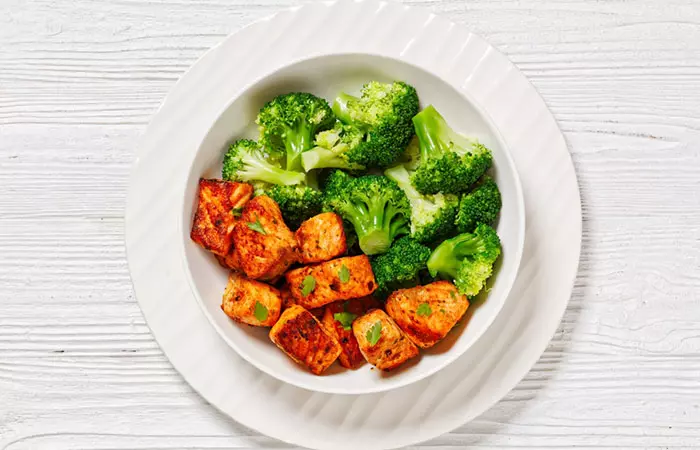
Ingredients
- 6 oz of salmon filets
- 1 cup of broccoli florets
- 1 tablespoon of olive oil
- Lemon juice
- Salt and pepper to taste
How To Prepare
- Preheat the oven to 375°F (190°C).
- Place the salmon filet on a baking sheet lined with foil.
- Drizzle olive oil and lemon juice over the salmon.
- Season with salt and pepper.
- Bake for about 15-20 minutes or until the salmon flakes easily with a fork.
- While the salmon is baking, steam the broccoli until tender.
- Serve the baked salmon with steamed broccoli on the side.
 Did You Know?
Did You Know?Although there are plenty of yummy recipes to try, the low-glycemic diet can have its own drawbacks. Check them out in the section below.
Drawbacks Of The Low-Glycemic Diet
- May Be Difficult To Track
A low-glycemic diet can be challenging to follow as it requires one to constantly monitor the GI value of foods. This can be a complex and arduous task and makes meal planning and dining out more cumbersome.
- May Have Limited Food Choices
While the diet’s focus remains on low-GI foods, some high-GI foods are also nutritious. Restricting them to adhere to the diet may lead to a lack of dietary variety. This may even cause one to miss out on some essential nutrients.
- May Offer Inadequate Energy For Some
While the steady energy provided by low-GI foods is advantageous in the long run, it might not be sufficient for individuals, like athletes, who would benefit from quick bursts of energy.
- May Be Inconvenient To Follow
Following a low-GI diet may be inconvenient in social situations or while traveling due to limited food choices, difficulties in finding suitable options, and the need for careful meal planning. This can make adhering to the plan a challenge.
- May Lead To Overemphasis On GI
Overemphasis on focusing on the GI of foods may lead some people to neglect other essential aspects of nutrition, such as portion sizes, overall calorie intake, and dietary balance.
- May Be Misinterpreted
It is possible to misinterpret the GI value of foods. This can lead to misconceptions about which foods are truly low- or high-GI.
Infographic: 5 Potential Benefits Of The Low Glycemic Diet
The low glycemic diet is a popular dietary approach that allows one to carefully include foods with a low glycemic index (GI) to help prevent rapid spikes in blood sugar levels. This diet can provide many other benefits. Check out the infographic below to learn more.

Illustration: StyleCraze Design Team
Frequently Asked Questions
Can I still enjoy treats and sweets when I am on a low-glycemic diet?
Yes, but they should be consumed in moderation. You may also consider better alternatives that are made with low-GI sweeteners. These allow you to satisfy your sweet cravings without causing any significant spike in your blood sugar levels.
Is a low-glycemic diet suitable for vegetarians or vegans?
Yes, it can be adapted to suit vegetarian or vegan preferences. Plant-based sources of protein, along with low-GI fruits, vegetables, and grains can be incorporated to create a balanced and sustainable diet.
What is the difference between a low-glycemic diet and a low-carb diet?
A low-glycemic diet primarily focuses on the quality and GI of carbohydrates and emphasizes low-GI foods. In contrast, a low-carb diet restricts overall carbohydrate intake regardless of the GI.
Is a low-glycemic diet sustainable?
Yes, it can be sustainable when properly planned. Its flexibility allows for a wide variety of food choices, making it achievable as a long-term dietary approach.
Illustration: The Low-Glycemic Diet: Food List, Recipes, Pros, And Cons

Image: Stable Diffusion/StyleCraze Design Team
Glycemic index and glycemic load are often confused. Check out the video below to learn about the differences, how they are calculated, and their importance.
References
Articles on StyleCraze are backed by verified information from peer-reviewed and academic research papers, reputed organizations, research institutions, and medical associations to ensure accuracy and relevance. Read our editorial policy to learn more.
- The effect of dietary glycaemic index on glycaemia in patients with type 2 diabetes: a systematic review and meta-analysis of randomized controlled trials
https://pubmed.ncbi.nlm.nih.gov/29562676/ - Glycemic index (gi) or glycemic load (gl) and dietary interventions for optimizing postprandial hyperglycemia in patients with t2 diabetes: a review
https://www.ncbi.nlm.nih.gov/pmc/articles/PMC7352659/ - A systematic review of the influence of rice characteristics and processing methods on postprandial glycaemic and insulinaemic responses
https://www.ncbi.nlm.nih.gov/pmc/articles/PMC4579564/ - Effects of ripening stage and steaming time on quality attributes of fat free banana snack obtained from drying process including fluidized bed puffing
https://www.ncbi.nlm.nih.gov/pmc/articles/PMC4837723/ - Low-glycemic index diets as an intervention for diabetes: a systematic review and meta-analysis
https://pubmed.ncbi.nlm.nih.gov/31374573/ - Insulin resistance
https://www.ncbi.nlm.nih.gov/books/NBK507839/ - Carbohydrates protein and performance
https://www.ncbi.nlm.nih.gov/books/NBK209054/ - Effects of dietary glycaemic index on adiposity glucose homoeostasis and plasma lipids in animals
https://pubmed.ncbi.nlm.nih.gov/15337404/ - The metabolic concept of meal sequence vs. satiety: glycemic and oxidative responses with reference to inflammation risk protective principles and mediterranean diet
https://www.ncbi.nlm.nih.gov/pmc/articles/PMC6835480/. - Beneficial effects of a 5-week low-glycaemic index regimen on weight control and cardiovascular risk factors in overweight non-diabetic subjects
https://www.cambridge.org/core/journals/british-journal-of-nutrition/article/beneficial-effects-of-a-5week-lowglycaemic-index-regimen-on-weight-control-and-cardiovascular-risk-factors-in-overweight-nondiabetic-subjects/9F874F4969E6E179E040ACEB15A53BB0 - Effects of the glycemic index of foods on serum concentrations of high-density lipoprotein cholesterol and triglycerides
https://pubmed.ncbi.nlm.nih.gov/11602065/ - Glycemic index glycemic load and glycemic response: an international scientific consensus summit from the international carbohydrate quality consortium (ICQC)
https://www.sciencedirect.com/science/article/pii/S0939475315001271
Read full bio of Janelle Bigelman
Read full bio of Aparna Mallampalli
Read full bio of Ravi Teja Tadimalla
Read full bio of Sindhu Koganti






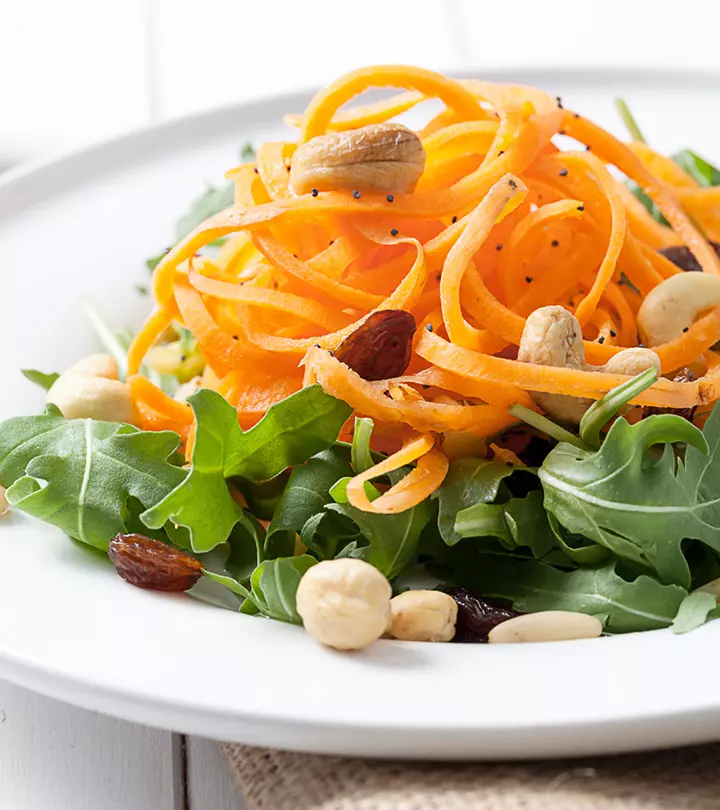


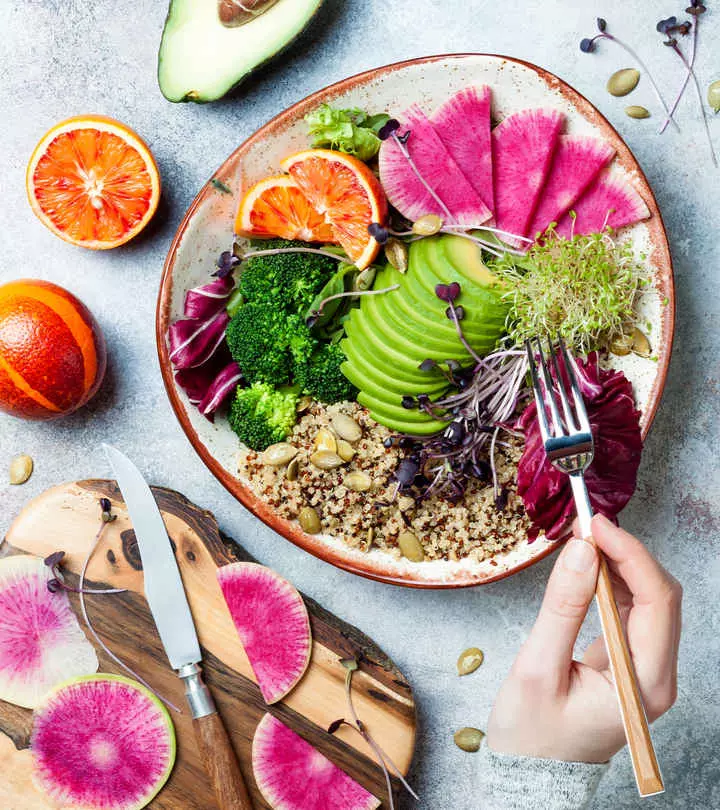








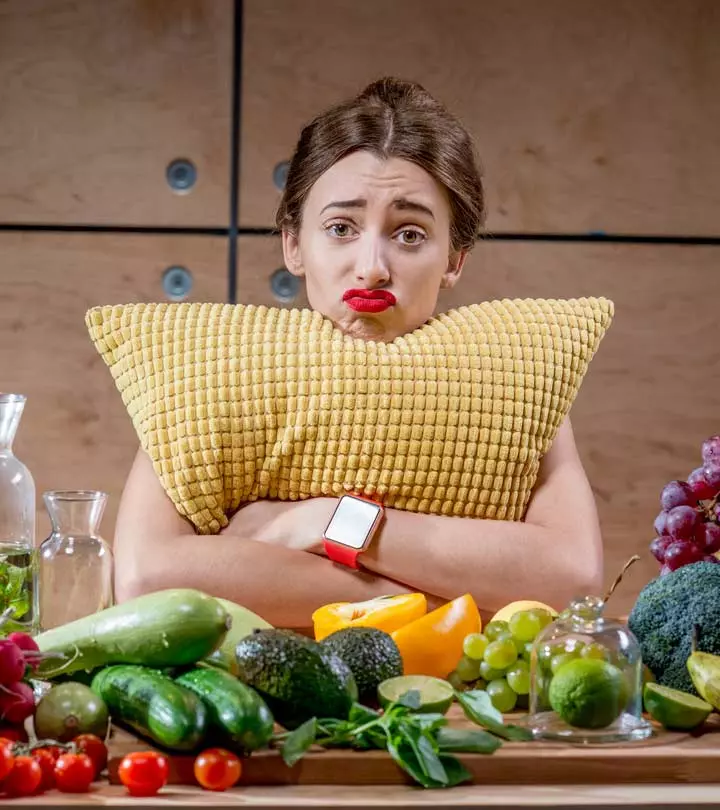
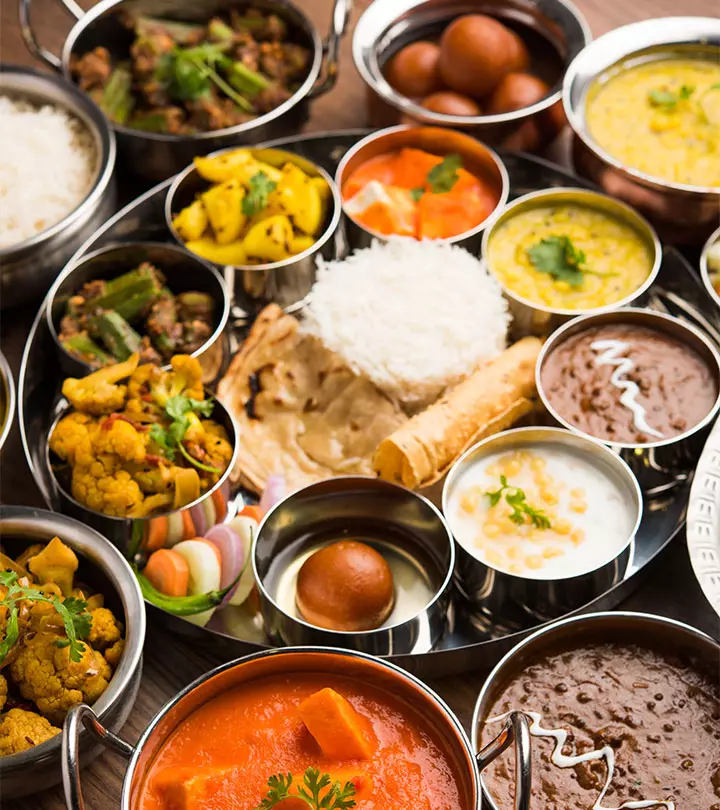







Community Experiences
Join the conversation and become a part of our empowering community! Share your stories, experiences, and insights to connect with other beauty, lifestyle, and health enthusiasts.